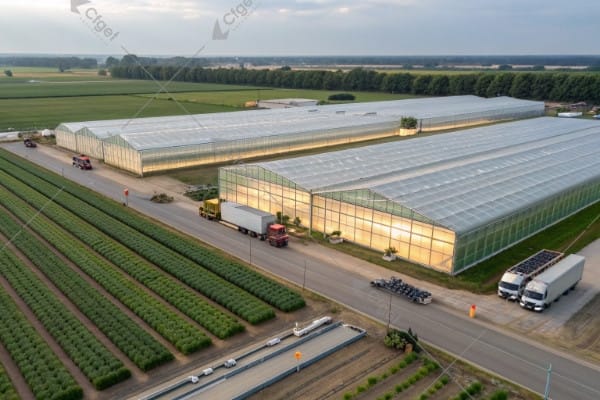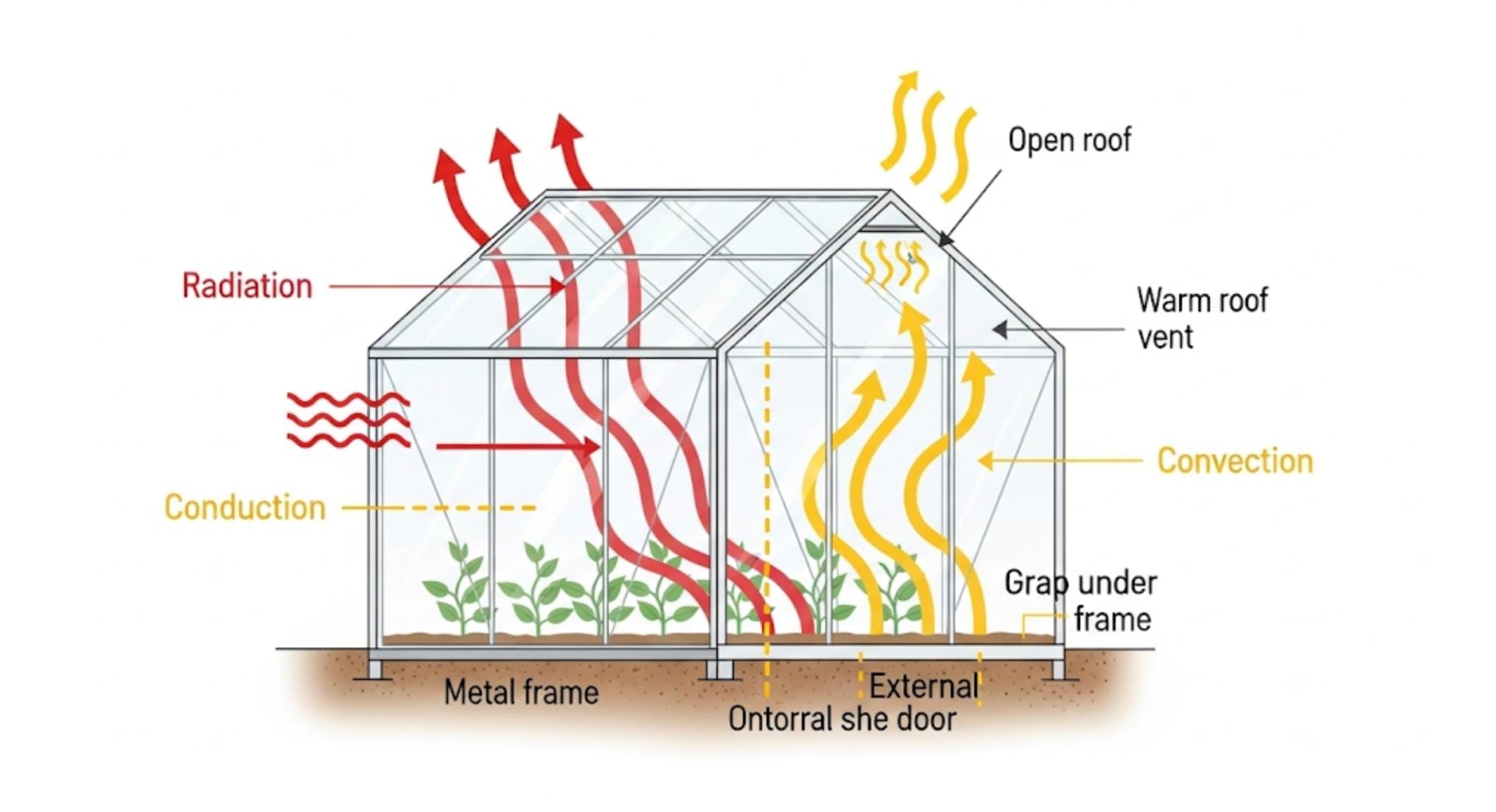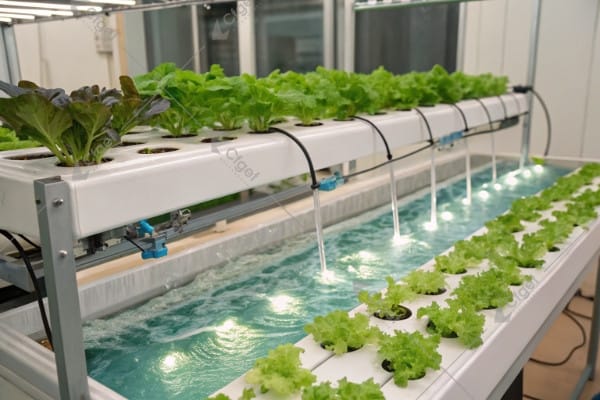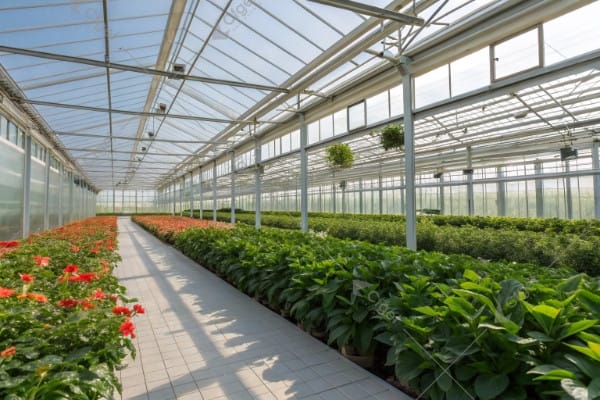Are you struggling with limited space or water resources for your crops? Traditional farming demands a lot, but what if there was a way to grow plants more efficiently? Hydroponics might be the answer you are looking for.
Hydroponics is a method of growing plants without soil. Instead, it uses mineral nutrient solutions dissolved in water. This approach allows you to grow more food using fewer resources, especially water and space, making it ideal for greenhouse environments.
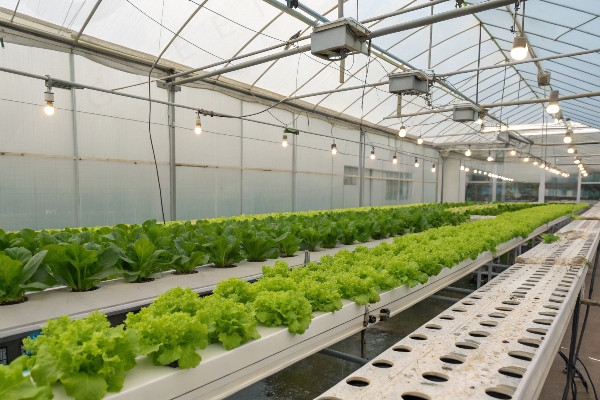
This method might sound futuristic, but it is a practical solution many growers are adopting today. It offers precise control over plant nutrition and can lead to impressive results. Let’s explore how this technology works and why it could be a game-changer for your greenhouse operation. As someone who has worked in greenhouse technology for over 28 years with CFGET, I have seen firsthand how transformative hydroponics can be.
Don’t Miss:——How Can You Keep a Greenhouse Warm During Winter Effectively?
What Exactly is Hydroponic Growing (Soil-less Farming Basics)?
Confused about growing plants without soil? It might seem complicated, but the basic idea is simple. Hydroponics provides everything a plant needs directly through water, cutting out the middleman – the soil.
Hydroponic growing, or soilless farming, is the practice of cultivating plants using a water-based nutrient solution instead of soil. Plant roots are supported by inert media like rockwool or perlite, or suspended directly in the nutrient-rich water.
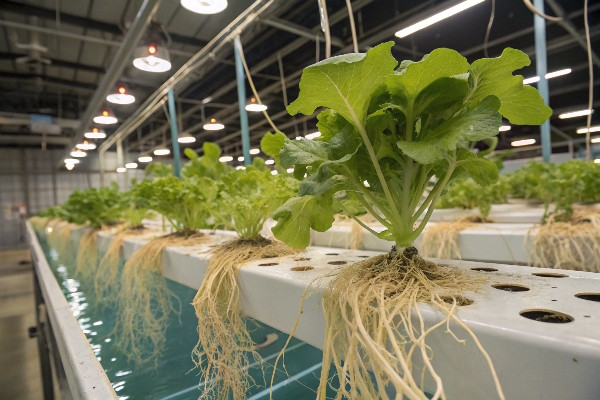
So, how does this actually work? In traditional soil farming, the soil acts as a reservoir for nutrients and water. Plants extend their roots into the soil to find and absorb these essential elements. Soil also provides physical support for the plant. Hydroponics removes the soil from the equation. Instead, we mix precise amounts of minerals – the nutrients plants need – directly into water. This nutrient solution is then delivered straight to the plant’s root system.
Think of it like giving plants a perfectly balanced meal directly, without them having to search for it. Because the nutrients are readily available in the water, plants do not need to expend as much energy developing extensive root systems to find food. They can focus more energy on growing leaves, stems, and fruits. This is one reason why hydroponic plants often grow faster than soil-grown plants.
While we call it "soilless," sometimes an inert growing medium is used. This medium does not provide nutrients like soil does. Its main job is to support the plant’s roots and hold moisture. Common examples include rockwool, perlite, vermiculite, coco coir (made from coconut husks), or even simple gravel or sand. In some systems, like Deep Water Culture (DWC), the roots hang directly in the nutrient solution with no medium other than perhaps a small starter plug.
The key is control. With hydroponics, I can precisely control the nutrients the plants receive. We measure the electrical conductivity (EC) to know the nutrient concentration and the pH to ensure the plants can absorb those nutrients effectively. This level of control is difficult, if not impossible, to achieve with soil, which naturally varies in composition and can buffer nutrient availability.
Here is a simple comparison:
| Feature | Soil-Based Growing | Hydroponic Growing |
|---|---|---|
| Growing Medium | Soil | Water with nutrient solution |
| Nutrient Source | Soil minerals, added fertilizers | Dissolved mineral salts in water |
| Nutrient Control | Difficult, buffered by soil | Precise control (EC, pH) |
| Water Delivery | Irrigation (often inefficient) | Direct to roots (often recirculated) |
| Root Environment | Variable (compaction, pests, etc.) | Controlled, often sterile |
| Support | Soil | Inert media or system structure |
From my experience at CFGET, helping growers set up hydroponic systems in diverse regions like Southeast Asia and Central Asia, the ability to bypass problematic local soil conditions is a massive advantage. Whether dealing with poor soil quality, contamination, or simply the desire for a cleaner growing environment, hydroponics provides a reliable foundation for cultivation. It simplifies many aspects of plant care once the system is understood and managed correctly.
Don’t Miss:——Is Glass the Best Material for Your Greenhouse Structure?
Key Advantages: Why Should You Choose Hydroponics for Your Greenhouse?
Are you wondering if switching to hydroponics is really worth the effort? Making changes in farming practices can feel daunting. But understanding the significant benefits hydroponics offers might convince you it is a smart move for your greenhouse.
Choosing hydroponics offers major advantages: significant water savings, faster plant growth, potentially higher yields, better space utilization (especially vertically), and fewer problems with soil-borne pests and diseases. It allows for greater control over the growing environment.

Let’s break down these advantages. Having worked with countless greenhouse operators through CFGET, I consistently see these benefits making a real difference in their success.
First, water conservation is huge. Traditional agriculture is thirsty. A lot of water evaporates or runs off before plants can even use it. Hydroponic systems, especially recirculating ones, use water much more efficiently. The water containing nutrients is delivered directly to the roots, and often, any unused solution is captured and reused. This can lead to water savings of up to 90% compared to traditional soil farming. This is incredibly important in water-scarce regions, a common challenge for some of our clients in Central Asia, but also increasingly relevant globally due to climate change.
Second, plants often grow faster. Why? Because nutrients are readily available in an easily absorbable form right at the roots. Plants do not waste energy growing large root systems searching for food. They put that energy into growing bigger, faster. Combined with the controlled environment of a greenhouse, you can often shorten the growth cycle and get more harvests per year.
Third, this often translates to higher yields. Faster growth cycles mean more crops over time. Also, hydroponics allows for higher planting density. Since plants are getting everything they need delivered directly, they do not compete as much for resources in the root zone as they would in soil. You can often grow more plants in the same amount of space. We have helped growers design systems that maximize their greenhouse footprint, sometimes incorporating vertical farming techniques where plants are grown in layers, dramatically increasing yield per square meter.
Fourth, space efficiency is a key factor, especially in greenhouses where space is valuable. As mentioned, higher density planting is possible. Vertical hydroponic systems take this even further, allowing you to multiply your growing area without expanding the greenhouse itself. This is perfect for urban farming or areas where land is expensive.
Fifth, you generally face fewer issues with soil-borne pests and diseases. Since there is no soil, common problems like nematodes, root rot fungi (if managed properly), and soil-dwelling insects are eliminated or significantly reduced. This means less reliance on pesticides and herbicides, leading to cleaner produce and potentially lower costs. This aligns well with the sustainability goals emphasized by our European clients.
Sixth, you have unparalleled control. You control the nutrient mix, the pH level, the watering schedule, and, within a greenhouse, the light, temperature, and humidity. This precision allows you to optimize conditions for specific crops, leading to better quality and consistency. At CFGET, we specialize in integrating these environmental controls with the hydroponic system itself.
Finally, hydroponics allows for year-round production regardless of external weather conditions, especially when implemented inside a greenhouse. You are not limited by seasons or poor weather. This provides a consistent supply chain and predictable income for growers.
Here’s a summary of the main benefits:
| Advantage | Description | Relevance |
|---|---|---|
| Water Savings | Recirculating systems use up to 90% less water than soil farming. | Crucial for arid regions, cost reduction, sustainability |
| Faster Growth | Direct nutrient access allows plants to grow faster, shortening cycles. | More harvests per year, quicker ROI |
| Higher Yields | Faster growth + higher plant density = more produce per area per time. | Increased profitability |
| Space Efficiency | Higher density planting and vertical farming potential maximize area usage. | Valuable for limited space, urban farming |
| Pest/Disease Control | Eliminates soil-borne issues, reducing need for pesticides. | Cleaner produce, lower costs, easier management |
| Nutrient Control | Precise delivery of optimized nutrient solutions. | Better crop quality, consistency |
| Year-Round Growth | Independent of seasons when combined with greenhouse controls. | Stable production, reliable income |
Of course, hydroponics requires initial investment and technical knowledge, but the long-term benefits often outweigh these factors, especially for commercial growers looking for efficiency and sustainability. We have seen growers in Southeast Asia appreciate the faster installation potential, while European clients focus on the precision and sustainability certifications achievable with these systems.
Boosting Yields & Saving Water: Is This the Hydroponic Edge?
Are you constantly looking for ways to increase your greenhouse output while managing resources like water carefully? Traditional methods can be limiting. Hydroponics offers a powerful combination: significantly boosting crop yields while drastically cutting water consumption.
Yes, hydroponics provides a distinct edge by delivering nutrients directly for optimal uptake, leading to higher yields. Simultaneously, its closed-loop or efficient delivery systems minimize water loss through evaporation and runoff, saving substantial amounts of water.
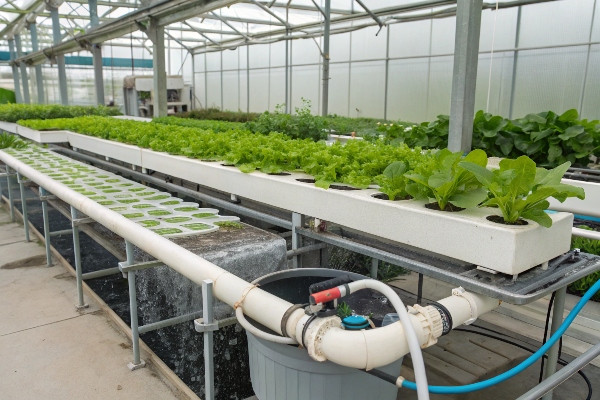
Let’s delve deeper into how hydroponics achieves these two critical goals. It is not magic; it is based on smart resource management and understanding plant physiology.
Yield increases come from several factors working together. First, as we have discussed, nutrients are perfectly balanced and instantly available to the roots. In soil, nutrients might be bound up or unevenly distributed. Plants have to work hard to get them. In hydroponics, it is like an IV drip of everything the plant needs, exactly when it needs it. This allows the plant to channel its energy into biomass production – leaves, fruits, flowers – instead of extensive root exploration. I remember visiting a client’s farm after they switched their tomato production to a CFGET hydroponic drip system. The sheer volume and uniformity of the fruit compared to their previous soil-based plots were striking. They reported nearly a 30% increase in marketable yield in the first year.
Second, the controlled root environment promotes healthier, more efficient roots. Oxygen availability, crucial for root respiration and nutrient uptake, can be optimized, especially in systems like DWC or aeroponics. Freedom from soil compaction allows roots to thrive. Healthy roots mean healthy, productive plants. Third, higher planting densities are possible. Because plants are not competing for water and nutrients in a limited soil volume, you can often place them closer together, effectively getting more plants, and thus more yield, from the same greenhouse space. Vertical systems amplify this dramatically. Fourth, the stable, optimized environment reduces plant stress. Consistent water, nutrients, and, in a greenhouse, climate control mean plants are less likely to suffer setbacks that reduce their potential yield.
Now, let’s talk water savings. This is where hydroponics truly shines compared to field agriculture or even traditional greenhouse soil beds. The primary mechanism is recirculation. In many popular systems (like NFT, DWC, Ebb & Flow), the nutrient solution that is not absorbed by the plants is collected and returned to the reservoir to be used again. This creates a closed loop where water loss is minimized primarily to transpiration (water released naturally by the plants) and a tiny amount of evaporation from the system surfaces. Compare this to soil irrigation, where much water is lost to deep percolation below the root zone, surface runoff, and evaporation from the soil surface itself.
Even in hydroponic systems that are not fully recirculating, like some drip systems using inert media, water application is highly targeted. Water is dripped slowly and directly to the base of each plant, ensuring it reaches the root zone with minimal waste. The absence of a large, exposed soil surface also significantly cuts down on evaporation. Calculations and real-world measurements consistently show water use reductions of 70%, 80%, even over 90% compared to conventional methods. This isn’t just environmentally responsible; it’s a significant operational cost saving, especially where water is priced high or rationed. For our clients in regions facing water stress, implementing efficient hydroponic systems designed by CFGET is not just an optimization, it’s often a necessity for viable commercial agriculture.
Here’s a breakdown of factors contributing to these advantages:
| Factor | Contribution to Higher Yields | Contribution to Water Savings |
|---|---|---|
| Nutrient Delivery | Direct, optimized, readily available for maximum uptake. | N/A (Relates more to nutrient efficiency) |
| Root Environment | Optimal oxygen, no compaction, reduced disease pressure. | Reduced evaporation from media vs. large soil surface. |
| Plant Density | Allows closer spacing, more plants per unit area. | N/A |
| Reduced Stress | Consistent conditions minimize growth setbacks. | N/A |
| Recirculation | N/A | Captures and reuses run-off, drastically cutting waste. |
| Targeted Irrigation | N/A | Delivers water precisely to roots, minimizing runoff/evap. |
| No Soil Evaporation | N/A | Eliminates significant water loss from soil surface. |
The combination of producing more crop with less water is the core economic and environmental argument for hydroponics in greenhouses. It aligns perfectly with the need for sustainable intensification – growing more food for a growing population without overburdening precious natural resources.
What are the Common Hydroponic Systems Suitable for Greenhouses (NFT, DWC, etc.)?
Feeling overwhelmed by the different types of hydroponic setups? Choosing the right system can seem confusing. Let’s explore the most common hydroponic systems used in greenhouses so you can understand your options.
Common hydroponic systems for greenhouses include Nutrient Film Technique (NFT), Deep Water Culture (DWC), Ebb and Flow (Flood and Drain)1, Drip Systems, and Aeroponics. Each has unique characteristics making it suitable for different crops and operational scales.

Choosing the right system depends on factors like the crops you want to grow, your budget, the size of your operation, and the level of technical expertise you have or are willing to develop. At CFGET, we guide clients through this selection process, considering their specific situation, including regional factors like climate in Southeast Asia or durability needs in Central Asia. Let’s look at the main types:
1. Nutrient Film Technique (NFT):
Imagine plants sitting in slightly sloped channels or gullies. A thin film (hence the name) of nutrient solution flows continuously down the channel, bathing the bare roots that dangle into the stream. The solution is collected at the end and pumped back to the start.
- Pros: Relatively low water volume, efficient nutrient delivery, good for lightweight, fast-growing crops.
- Cons: Susceptible to pump failure (roots dry out quickly), roots can sometimes clog channels if they get too dense, requires precise slope.
- Best suited for: Leafy greens (lettuce, spinach, basil), strawberries. It’s quite popular in commercial greenhouses for these crops.
2. Deep Water Culture (DWC):
In DWC, plants are typically placed in rafts (like styrofoam) or net pots that float on top of a deep container filled with oxygenated nutrient solution. The roots are submerged 24/7 in this solution. An air pump with air stones provides constant oxygen to prevent roots from drowning.
- Pros: Simple concept, relatively inexpensive to set up initially, provides a good buffer against pump failure (roots stay wet), excellent growth for water-loving plants.
- Cons: Requires good aeration, water temperature management can be critical (warm water holds less oxygen), larger water volume than NFT.
- Best suited for: Lettuce, herbs, other leafy greens. Can be adapted for larger plants but may require more support.
3. Ebb and Flow (Flood and Drain / Tidal):
This system uses a grow bed filled with an inert medium (like gravel, perlite, or rockwool). A reservoir below holds the nutrient solution. Periodically (controlled by a timer), a pump floods the grow bed with the solution, feeding the roots. Then, the solution drains back into the reservoir via gravity. This cycle repeats multiple times a day.
- Pros: Versatile (can use various media), provides excellent root aeration as medium drains, good wetting of the root zone.
- Cons: Requires timers and reliable pumps/drains, medium needs to be chosen carefully, can be heavier than other systems.
- Best suited for: Wide variety of plants, including herbs, leafy greens, and some fruiting plants like peppers or beans, depending on the medium depth. This system reflects the "tidal irrigation" mentioned in my insight.
4. Drip Systems:
These are very common, especially in commercial greenhouses for larger plants. Plants grow in individual containers or slabs filled with an inert medium (coco coir, rockwool, perlite). A network of tubes delivers nutrient solution slowly and directly to the base of each plant via emitters (drippers). The system can be recirculating (collecting runoff) or non-recirculating (drain-to-waste).
- Pros: Highly scalable, precise control over watering frequency/duration for each plant, adaptable to various media and container types, suitable for large plants.
- Cons: Emitters can clog, requires careful management of watering schedules, non-recirculating systems can be less water-efficient (though still better than soil).
- Best suited for: Tomatoes, cucumbers, peppers, melons, flowers – crops that need support and have larger root systems. CFGET often recommends and designs sophisticated drip systems for high-value crop producers.
5. Aeroponics (Atomization):
This is arguably the most high-tech method. Plant roots hang suspended in the air within a chamber. Nutrient solution is periodically sprayed onto the roots as a fine mist or fog. This provides maximum oxygen exposure to the roots.
- Pros: Fastest growth rates possible due to high oxygen levels, very efficient water and nutrient use.
- Cons: Highly dependent on misting equipment (nozzles can clog, pump failure is critical), requires precise control, generally higher setup cost and technical skill needed.
- Best suited for: Root crops (potentially), leafy greens, cloning/propagation, research purposes. It matches the "atomization irrigation" concept from my insight.
Here’s a comparative overview:
| System Type | How it Works | Common Crops | Key Considerations |
|---|---|---|---|
| NFT | Thin film of solution flows over bare roots | Leafy greens, strawberries | Pump dependency, channel clogging, precise slope |
| DWC | Roots submerged in oxygenated solution | Lettuce, herbs | Aeration vital, water temperature, large water volume |
| Ebb & Flow | Periodic flooding/draining of grow bed medium | Versatile, many herbs/veg | Timers, pump/drain reliability, medium choice |
| Drip System | Solution dripped onto medium around plant base | Tomatoes, cucumbers, peppers | Scalable, emitter clogging, schedule management |
| Aeroponics | Roots misted with nutrient solution in air | Leafy greens, propagation | High-tech, nozzle/pump dependency, cost, precision |
My experience tells me that there is no single "best" system. The ideal choice emerges from a careful analysis of the grower’s goals, resources, and the specific requirements of the crops they intend to cultivate. For instance, a grower in Southeast Asia might prioritize systems robust against high humidity (perhaps favouring DWC or certain drip setups), while a research institution in Europe might invest in the precision of aeroponics. Our role at CFGET is to provide that expertise and tailor the system design for optimal performance and long-term success.
Conclusion
In short, hydroponics offers a powerful way to grow plants efficiently inside a greenhouse. It saves water, often boosts yields, and gives you amazing control, letting you truly grow more with less.
Discover the Ebb and Flow system and how it can benefit various types of plants in hydroponics. ↩

